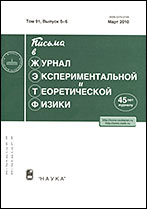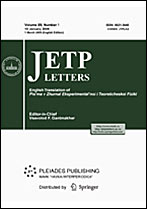|
|
Pis'ma v Zhurnal Èksperimental'noi i Teoreticheskoi Fiziki, 2003, Volume 77, Issue 7, Pages 412–416
(Mi jetpl2774)
|
 |
|
 |
This article is cited in 11 scientific papers (total in 11 papers)
Spectroscopy of the $^5$H superheavy hydrogen isotope
M. G. Gornova, M. N. Bera, Yu. B. Gurova, S. V. Lapushkina, P. V. Morokhova, V. A. Pechkurova, N. O. Poroshina, V. G. Sandukovskiib, M. V. Tel'kusheva, B. A. Chernysheva
a Moscow Engineering Physics Institute
b Joint Institute for Nuclear Research, Dubna, Moskovskaya obl.
Abstract:
The formation of the $^5$H superheavy hydrogen isotope was experimentally sought in the reactions induced by stopped $\pi^-$ mesons absorbed by $^9$Be nuclei. Peaks in missing-mass spectra were observed in two reaction channels, $^9$Be$(\pi^-, pt)X$ and $^9$Be$(\pi^-, dd)X$, and were attributed to the $^5$H resonance states. The lowest state has parameters $Er=5.5\pm0.2\,$MeV and $\Gamma=5.4\pm0.5\,$MeV [$E_r$ is the resonance energy measured from the (triton + two neutrons) threshold]. Therefore, $^5$H is bound more weakly than $^4$H. Excited states of $^5$H were also observed. All three resonance levels ($E_{1r} = 10.6\pm 0.3\,$MeV, $\Gamma _{1r} = 6.8\pm0.5\,$MeV; $E_{2r} = 18.5\pm0.4\,$MeV, $\Gamma _{2r} = 4.8\pm1.3\,$MeV, $E_{3r} = 26.7\pm0.4\,$MeV, $\Gamma _{3r} = 3.6\pm1.3\,$MeV) can decay into five free nucleons.
Received: 24.06.2002
Revised: 12.02.2003
Citation:
M. G. Gornov, M. N. Ber, Yu. B. Gurov, S. V. Lapushkin, P. V. Morokhov, V. A. Pechkurov, N. O. Poroshin, V. G. Sandukovskii, M. V. Tel'kushev, B. A. Chernyshev, “Spectroscopy of the $^5$H superheavy hydrogen isotope”, Pis'ma v Zh. Èksper. Teoret. Fiz., 77:7 (2003), 412–416; JETP Letters, 77:7 (2003), 344–348
Linking options:
https://www.mathnet.ru/eng/jetpl2774 https://www.mathnet.ru/eng/jetpl/v77/i7/p412
|


| Statistics & downloads: |
| Abstract page: | 167 | | Full-text PDF : | 56 | | References: | 33 |
|





 Contact us:
Contact us: Terms of Use
Terms of Use
 Registration to the website
Registration to the website Logotypes
Logotypes








 Citation in format
Citation in format 
